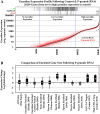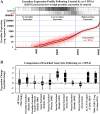CSR-1 and P granules suppress sperm-specific transcription in the C. elegans germline
- PMID: 25968310
- PMCID: PMC4440928
- DOI: 10.1242/dev.121434
CSR-1 and P granules suppress sperm-specific transcription in the C. elegans germline
Abstract
Germ granules (P granules) in C. elegans are required for fertility and function to maintain germ cell identity and pluripotency. Sterility in the absence of P granules is often accompanied by the misexpression of soma-specific proteins and the initiation of somatic differentiation in germ cells. To investigate whether this is caused by the accumulation of somatic transcripts, we performed mRNA-seq on dissected germlines with and without P granules. Strikingly, we found that somatic transcripts do not increase in the young adult germline when P granules are impaired. Instead, we found that impairing P granules causes sperm-specific mRNAs to become highly overexpressed. This includes the accumulation of major sperm protein (MSP) transcripts in germ cells, a phenotype that is suppressed by feminization of the germline. A core component of P granules, the endo-siRNA-binding Argonaute protein CSR-1, has recently been ascribed with the ability to license transcripts for germline expression. However, impairing CSR-1 has very little effect on the accumulation of its mRNA targets. Instead, we found that CSR-1 functions with P granules to prevent MSP and sperm-specific mRNAs from being transcribed in the hermaphrodite germline. These findings suggest that P granules protect germline integrity through two different mechanisms, by (1) preventing the inappropriate expression of somatic proteins at the level of translational regulation, and by (2) functioning with CSR-1 to limit the domain of sperm-specific expression at the level of transcription.
Keywords: C. elegans; CSR-1; Germ granules; Germline; Germline sex determination; P granules; Sperm; Spermatogenesis.
© 2015. Published by The Company of Biologists Ltd.
Figures





References
Publication types
MeSH terms
Substances
Grants and funding
LinkOut - more resources
Full Text Sources
Other Literature Sources
Molecular Biology Databases
Research Materials

